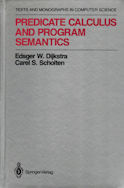Rather than choosing one of the existing programming languages to work with, he has designed a mini-language that helps to stress the more fundamental aspects of the programming task. It facilitates nontrivial, satisfactory designs, enabling the user to go to the core of the problem quickly without getting caught up in the intricacies of handling a more complex language.
Stressing the formal aspects of correctness proving and program derivation,
as well as the formal aspects of problem solving, the book:
• Introduces “predicate transformers” as a means for defining the semantics of programming languages.
• Derives theorems about alternative and repetitive constructs that are functionally valuable in program composition.
• Emphasizes the necessity of total correctness.
• Spotlights the intertwined processes of problem solving
and program development in a series of efficiently worked-out examples.
For longer programs that solve more difficult problems, it records fully the true design history.
Written for those with a basic knowledge of computer programming, this book points the way toward future refinements in methods and accuracy through the time-honored approach of treating complicated problems in a simplified manner.

